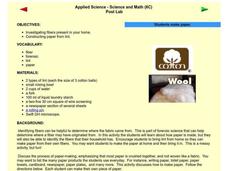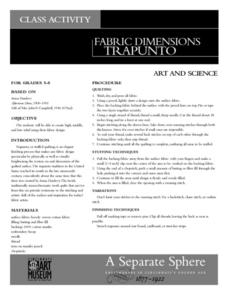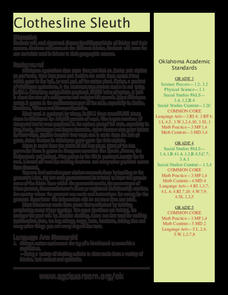Curated OER
Fiber Fusion
Create works of art using fabric. Learners use fabric, tissue paper, acrylic gel, and paint to create a unique and interesting piece of work. They discuss the different techniques that can be used to create works of art and evaluate...
Global Oneness Project
Rethinking the Fabrics We Wear
What are fibersheds and what what do they have to do with environmental protections? A photo essay and audio recordings about Mimi Luebbermann, and her sheep, cause consumers to reflect on how their clothing choices can support local...
Curated OER
Fabrics and Polymers
Students explore natural resources by reading a science story in class. In this fibers lesson, students identify and discuss the differences between fibers such as wool, silk, rayon, linen and cotton. Students identify the common uses of...
Curated OER
Fibers and Fabric
Students are introduced to a variety of different fibers. After acting out a short story, they discover how yarn and basic weaves are made. To end the instructional activity, they practice making their own weave pattern using paper...
Curated OER
Fabric Construction Chart
Students in sewing class review the various types of natural and synthetic fabrics. They take notes about fabric construction and match woven, knit, and non-woven fabric samples to fabric construction charts. They make specific...
Curated OER
Natural Fibers/Textiles
Young scholars identify basic fibers, the characteristics, use and care of each textile. They sort fibers by identifying the appropriate characteristics of natural fibers. In the end, they participate in a textile bingo game.
Curated OER
Natural Fibers and Textiles
Students sort fibers by identifying the appropriate characteristics of natural fibers. After sorting, students determine the difference between man-made and natural fibers, and play textile bingo.
Curated OER
Burlap Weaving Gone Wild
Explore art using fabric with this resource. Learners talk about weaving and create art work after discussing this important technique. This is a great way integrate art and history.
Curated OER
Applied Science - Science and Math Lab
Students examine fabric. In this Applied Science lesson, students look at the fibers of fabric through a microscope. Students compare and contrast a variety of fibers.
Curated OER
Applied Science - Science and Math Post Lab
Students construct paper. In this applied Science instructional activity, students create paper using lint. Students investigate the different fibers in their homes.
Curated OER
Interior Design- Textiles
Students investigate natural and synthetic fibers. In this textiles lesson, students pass around samples of carpet, drapes and clothing and decide what they are made of. Students use KWL charts to organize information from reading and...
Curated OER
Fabric Dimensions
Students create original examples of the trapunto quilting technique in this middle-level lesson sutied for the Art classroom. Assessment and discussion questions are included for this lesson.
Dick Blick Art Materials
Matisse Prints du Soleil
The sun provides the link between this art and science activity. Kids use sunlight (or light from an artificial source) to produce heliographic prints on fabric or paper.
Curated OER
Clothesline Sleuth
Learners explore the make up of fabrics. In this agriculture activity, students examine the cotton and wool crops of the United States and discover how fabrics are created.
Curated OER
Clothesline Sleuth
What fabrics are our clothes made of? Where do those fabrics from? Lead your pupils to discover the answers to these questions and more. Class members have a chance to play with various fabrics, invesitgating the materials and...
Curated OER
Clothesline Sleuth
Third graders discover the origin of an item of clothing. For this clothing lesson, 3rd graders navigate the net to locate information related to various fabrics. Students answer questions and define vocabulary about...
Curated OER
Warm Up to Weaving With the Right Lesson Plans
Explore the process of creating the fabrics, cloths, blankets, and rugs that warm the chilly months of winter with weaving lesson plans.
Curated OER
CLOTHESLINE SLEUTH
Pupils will trace origins of various forms of clothing to their agricultural sources.String a cotton cord across the top of a blackboard to resemble a clothesline. 2. Bring a variety of clothing articles to class made from a variety of...
Curated OER
Nanofibers on Your Clothes
Students relate the presence of nanofibers in clothing to its ability to repel stains. They observe and contrast the characteristics of nanofiber, Scotchguard treated, and regular fabric then test the stain resistance of each fabric...
Curated OER
Telling Tales About Textiles
Learners analyze the different types of textiles, processes for creating cloth, and inventions utilized to manufacture industrial goods. In this Telling Tales About Textiles lesson, students weave on a card loom to create their own...
Curated OER
Textile Selection
Students identify various textiles and factors that lead to the selection of specific textiles. They put their knowledge of textiles to use by selecting the textiles that they would use in an interior that they have designed.
Curated OER
Embroidery As A Form Of Art
Young scholars create a "class quilt" using techniques learned from the study of Asian textile practices in this six-day lesson for upper-elementary school. This lesson requires parent volunteers.
Sargent Art
Resist Collage/Painting on Gesso Board
Young artists mix it up by crafting a resist collage painting on a gesso board, and in the process, learn how different media embellish and affect the surface of their work. After analyzing images of the works of Mary Todd Bean and...
Dick Blick Art Materials
Stitch It Up!
Ever think about combining the art forms of painting and embroidery? Then this art lesson is right up your alley! Given a piece of white cloth, young artists first create a grayscale painting and then highlight certain...

























